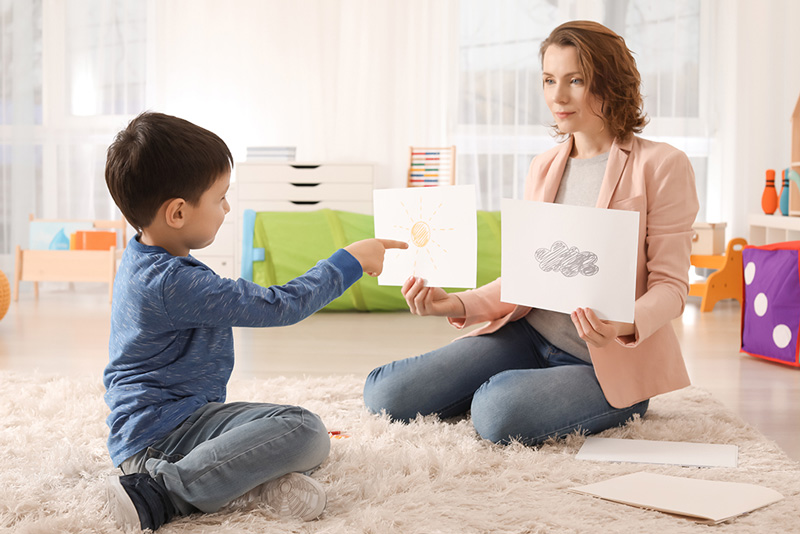What do a wheelchair, closed captioning on a television screen, and a visual schedule all have in common? They are part of an extensive list of products or services that enable those with disabilities to access activities of daily living. Like a wheelchair, assistive technology can provide individuals with autism assistance in accessing activities of daily living. Assistive technology can bridge the gap that these individuals face in those areas and improve their ability to be independent and a fully integrated member of their community.

Assistive Technology and Autism
The American Psychiatric Association defines Autism Spectrum Disorder (ASD) as a complex developmental condition involving persistent challenges with social communication, restricted interests, and repetitive behavior. The National Institute on Deafness and Other Communication Disorders further defines ASD as a developmental disability that can cause significant social, communication, and behavioral challenges. The term “spectrum” refers to the wide range of symptoms, skills, and levels of impairment people with ASD may possess. Those who have experience in working with individuals with ASD or have loved ones with the disorder know all too well that the “spectrum” of deficits for these individuals can vary greatly.
One of the most prevalent impairments for people with ASD is the inability to communicate effectively. They often have trouble developing language skills, interpreting nonverbal communication, and processing what others are saying to them. Assistive technology can be an invaluable tool to help facilitate communication for a person with limited communication skills.
Assistive Technology in Schools
The federal law enacted to protect students with disabilities, the Individuals with Disabilities Education Act (IDEA), defines an assistive technology device as “any item, piece of equipment, or product system, whether acquired commercially off the shelf, modify, or customized, that is used to increase, maintain, or improve functional capabilities of a child with a disability.” The IDEA further states that on a case-by-case basis, the use of school-purchased assistive technology devices in a child’s home or in other settings is required if the child’s Individualized Education Program’s (IEP) Team determines that the child needs access to those devices in order to receive a free and appropriate education (FAPE) (Individuals with Disabilities Education Act, 2004). In addition to the IDEA, the Americans with Disabilities Act (ADA) and Section 504 of the Rehabilitation Act (Section 504) provide that students with disabilities are entitled to access places of public accommodations, including schools, and are entitled to a FAPE.
Under the IDEA, students with disabilities are entitled to an IEP which includes access to special education and related services. The purpose of the ADA is to ensure that people with disabilities are afforded the same rights and opportunities as everyone else, and a 504 Plan provides accommodations to permit students to access their education. Under either an IEP or a 504 Plan, students with ASD may be entitled to assistive technology. School districts have an obligation to assess children in all areas of suspected disabilities. Therefore, if a student with autism has difficulty accessing their education, assessments can be provided to determine what programs, services, and assistive technology can be useful for the student. School districts can provide assistive technology evaluations either in-district or via an outside agency to determine what type of assistive technology may benefit the student.
No-Tech, Low-Tech, and High-Tech Assistive Technology
There are three categories of assistive technology that can be provided to disabled individuals. No-tech is usually free to low-cost and requires little to no training. It can be something as simple as a pencil grip or slanted workspace. Low-tech assistive technology may have some cost associated with it and may require training; devices such as headphones or a modified keyboard would be considered low-tech options. High-tech assistive technology is the most sophisticated and is usually costly and requires extensive training. Devices such as an augmentative and alternative communication device (AAC) or specialized software would be considered high-tech.
A Closer Look: Augmentative and Alternative Communication Devices
The American Speech-Language-Hearing Association (ASHA) defines, Augmentative and Alternative Communication as “all the ways that someone communicates besides talking” (American Speech-Language-Hearing Association, n.d.). For those with communication impairments, including those with ASD, AAC devices can enable them to communicate functionally with the world around them. Within AAC there can be low and high-tech options. The Picture Exchange Communication System (PECS) is the presentation of everyday activities on pictures or cards. Higher technology options can include actual devices, such as an iPad loaded with specific software that can generate speech and be customized. This can enable an individual to participate in conversations, ask and answer questions, and to have the ability to socialize without having to speak verbally. Speech and language therapists often are the professionals that are most familiar with the utilization of these devices and should be a part of the evaluation, implementation, and training process, either through private therapy or within a school system.
ASHA notes that there are common concerns when deciding to use an AAC device. Concerns such as “Is my child too young to use a device?” or “Will using an AAC device will prevent my child from learning to talk?” are common and both are typically misconceptions about these devices. According to ASHA, children younger than 3 can learn to use a device, and AAC devices do not slow down communication skills; they actually can help in the production of speech and are used in tandem with verbal communication. Finally, people of all ages can use an AAC device to communicate, not just children (American Speech-Language-Hearing Association, n.d.).
The Best Types of Assistive Technology for Individuals with ASD
When deciding what is the right type of assistive technology to use with children, adolescents, and adults with autism, the first place to start is by evaluating the educational and functional needs of that person. Evaluations such as speech and language, occupational therapy, physical therapy, assistive technology, and assistive and augmentative communication can be done privately, through a local education authority (such as a public school), or through a government agency. These evaluations can determine what the needs of the individual are, and what services and devices can support those needs.
Some of the most common assistive technology that those with autism access are visual boards which display routines, daily living skills, and schedules, sign language, PECS, AAC devices, stress balls, manipulatives, weighted blankets, and social stories and scripts which enable individuals to link visual information and strategies to improve social situations.
How to Obtain Assistive Technology
If you have a school-aged child between the ages of 3-21, you can request that your local school district evaluate your child. If it is determined that a student needs a program or service, either an IEP or Section 504 Plan can be developed. If you have or are an older individual with ASD, you can contact your state government to access support, including evaluations, therapies, and general assistance.
Impact of Assistive Technology on Individuals with ASD
In a 2018 study on the impact of assistive technology on individuals with autism, the authors found in a longitudinal study of the impact of assistive technology and ASD that the use of assistive technology demonstrated a positive increase in speech, social communication, and motor skills (Bollin, A., VanderMolen, J., & Bierwagen, T., 2018, p. 122). The authors noted that in all the studies they reviewed on assistive technology and ASD, there was an “increase in abilities of children” (Bollin, A., et al., 2018, p. 122).
In sum, with the use of assistive technology, individuals with ASD can increase their ability to access services, communicate functionally, gain independence in navigating the world around them, and live a more fulfilling life.
Anne Reynolds is a Senior Education Advocate at the law firm of Manes & Weinberg, LLC, Special Needs Lawyers. Anne works with families that need assistance in navigating the challenging world of special education. Anne is a graduate of Rutgers University, is a member of the Council of Parent Attorneys and Advocates (COPAA) and is the co-author of an article on the school district’s legal obligation to identify and provide instruction for struggling readers.
References
American Psychiatric Association. (2021) What is Autism Spectrum Disorder? https://www.psychiatry.org/patients-families/autism/what-is-autism-spectrum-disorder
Amerian Speech-Language-Hearing Association. Augmentative and Alternative Communication (AAC) https://www.asha.org/public/speech/disorders/aac/
Autism Spectrum Disorder: Communication Problems in Children. https://www.nidcd.nih.gov/health/autism-spectrum-disorder-communication-problems-children#4
Bollin, A. B.S. T.R. C.T.R.S., VanderMolen, J., Ph.D, Bierwagen, T. (2018). The Impact of Assistive Technology on Autism Spectrum Disorder: A Systematic Review, 122. https://files.eric.ed.gov/fulltext/EJ1254606.pdf
Individuals with Disabilities Act, 20 U.S.C. § 300.105 and § 1401 (2004). https://sites.ed.gov/idea/statute-chapter-33/subchapter-i/1401 https://sites.ed.gov/idea/regs/b/b/300.105
National Institute on Deafness and Other Communication Disorders. (2020, April)





